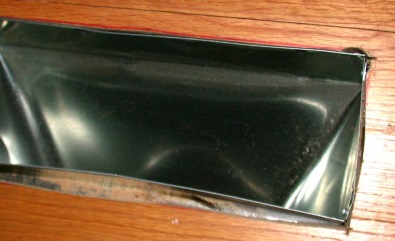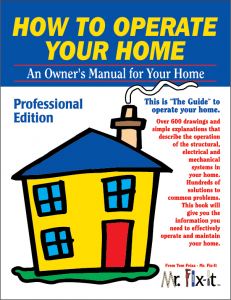IAQ IQ, Winter 2015-2016
©2015, Jeffrey C. May
In the last few months, I’ve worked with a number of people who moved into their homes within the last year. Some of them complained to me that the issues I found should have been noted by their home inspectors.
In most of these instances, I disagreed, because in Massachusetts at least, home inspectors are not required to point out environmental issues. But in a few of these instances, I agreed with my clients. There were, in my opinion, some issues that the home inspectors should have noted in these properties and discussed with their clients – even though the issues are not part of the Massachusetts or ASHI Standards of Practice (SOP). (The ASHI Reporter recently had a dialogue on the issue of going beyond the SOP in discussing safety.)
Here are some examples:
In one home, there was an open return in a musty-smelling crawl space. The crawl space was accessible, so the home inspector could have recognized that the crawl-space return might be entraining moldy air into the system: a potentially unhealthy situation.

I have also seen supplies in crawl spaces. While this is allowed for unventilated crawl spaces in the new Building Code, when the system isn’t running, moldy crawl-space air can move passively into the supply duct and from there, flow into rooms above grade – particularly just after the heating system shuts down, and all the warm air rises out of the duct system.
In my opinion, crawl spaces should be isolated from the interior of the home and dehumidified, rather than ventilated to the indoors or outdoors. A clean crawl space can also be open to a dehumidified basement, but that crawl space should have a clean floor (meaning concrete or an adequate vapor barrier attached to the foundation walls) and should not have exposed fiberglass insulation, which captures biodegradable dust and attracts pests.
In another property, the ducts were all made of duct board. My clients told me that the listing broker had informed them as well as the home inspector that the “ducts” had been cleaned before the property went on the market. The home inspector should have known (or at least suspected) that duct-board ducts cannot be adequately cleaned, and should have recommended further evaluation by an air quality professional. My clients, who had allergies, bought the house and were then faced with expensive replacement of all accessible ducts, which were soiled and moldy.
Here’s another problem I observed. Not only had the home inspector not discussed it, but the couple was about to get divorced because the husband thought that the wife was crazy.
She kept insisting that she often experienced headaches after spending time folding clean clothes in the basement laundry room of the couple’s new home. Her physician couldn’t find anything wrong with her, so she was convinced that there was something amiss in the house. The husband was there during the inspection, and as the three of us descended into the basement, he mumbled that she was imagining things, and that she was just trying to get him to fold the laundry.
I saw that the mechanical-room fresh air intake and the vent pipe for the direct-vent furnace exited the house within a few feet of each other in an area that was an interior angle between the garage and the house (the house and the garage were at right angles to each other). In addition, there was a large roof overhang that restricted air mixing.
When the fresh-air system for the mechanical room was running, it sucked in combustion products. And the table where the woman folded laundry was located directly beneath the fresh-air supply at the ceiling. The solution? The fresh air intake had to be moved, and the boiler combustion checked for carbon monoxide.
When I explained the problem to the couple, the wife felt vindicated and was pretty angry with her husband for not believing her. I’m not sure if they are still married, but since my inspections have resulted in several divorces, I wouldn’t be surprised if they separated after that.
I am writing this article because I used to be in the pre-purchase home inspection business, and I’m concerned about issues that home inspectors sometimes ignore, when it’s in their best interest to recommend further evaluation.
Here are some suggestions and warnings I’d like to share with you:
- If you find mechanical equipment or open duct work in a crawl space with a dirt floor and/or a musty smell, sound the alarm!
- Boots should be airtight to the flooring, so that air from a musty crawl space will not flow up around the boots into the rooms above.

- When a property has an exterior chimney which serves mechanical equipment, you may want to check the draft or look for signs of back-drafting at the draft diverter.
- A direct-vent for a furnace or boiler should not be located under an operable window, and should be high enough so as not to be covered by snow (remember last winter!).

Winter Snow: Get Ready!
Farmer’s Almanac
- Duct board is a problem. Period.
- A number of times I’ve removed expensive, pleated media filters from air conditioning units, only to find the original, cheap filters still sitting underneath the air conditioning coils. Those cheap filters have often been there for years, and are old and moldy. If you remove the filter during your inspection and find this second filter, point this out to the buyer. To make the larger point, I encourage you to open up the access panels to a furnace or air handler for inspection. If you don’t include this in your service, recommend that your client have the unit inspected by an HVAC technician, especially if your client has allergies or asthma.
- A dryer vent should exhaust to the exterior and not into a garage, basement, attic, or crawl space.


For those of you who are old enough, remember during the beginning of the energy-conservation movement, some people vented their dryers indoors to save on energy costs? Imagine all the moisture and biodegradable lint that was dispersed into these houses. Makes me shudder!
- A bathroom exhaust should never vent into the attic or soffit. If vented into the soffit, air flows just carry the moist air back into the attic. That moisture does not condense when the attic is hot, but when the attic is cold, the moisture condenses and fuels mold growth (usually heaviest on the north- or east-facing gable of the attic).



- I can’t tell you how many ridge vents I’ve seen where slots haven’t been cut for ventilation. What a rip-off!
- Control of roof water at the exterior is always important, as we all know, but of particular importance when a basement is finished – and has carpeting and/or a raised floor.

I like to think of home inspectors as similar to “personal care physicians.” Both are generalists, who when appropriate direct their clients (patients) to specialists. I encourage you to do the same.
Recommend that your clients purchase “How To Operate Your Home,” by “Mr. Fix-It” (Tom Feiza), http://htoyh.com/htoyh/. It’s a terrific resource for all homeowners, but especially for first-time buyers.
Happy Holidays, and all wishes for a healthy and productive New Year.
